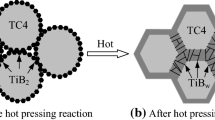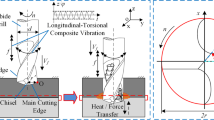Abstract
With the gradual promotion and the application of difficult-to-machine materials such as titanium matrix composites in the aerospace field, high-quality hole-making technology has become a major demand in aviation manufacturing. In order to improve the hole-making quality of TiBw/TC4 composites, asynchronous mixed frequency vibration-assisted hole-making (AMFVAHM) method is proposed. The process consists of two steps: ultrasonic vibration-assisted drilling (UVAD) base hole and low-frequency torsional vibration-assisted helical milling (LFTVAHM) target hole. Based on this process, the cutting trajectory modeling is established, and the hole-making experiment on TiBw/TC4 composites is conducted. The experimental data show that during the hole expansion stage, the maximum XY-plane average milling force decreases by 30.96% and the maximum axial average milling force decreases by 24.49% compared with conventional helical milling (HM) when the torsional vibration frequency and the milling frequency are the same in LFTVAHM. The hole-making experiment shows that AMFVAHM can reduce the chip size, tool wear, and some other defects such as entrance/exit burrs, scratches, and fractures of the hole wall. Comparing with HM and UVAD, the verticality of hole wall increases by 71.43% and 86.21%, the inlet damage decreases by 27.98% and 31.60%, the outlet damage decreases by 2.80% and 14.47%, the hole wall roughness (Ra) decreases by 36.29% and 63.43%, and the maximum white layer thickness decreases by 19.99% and 67.66%. Meanwhile, AMFVAHM process not only reduces the cutting force and cutting temperature but also improves the hole-making quality due to the fretting friction effect of LFTVAHM in secondary hole expansion, which meets the need for high-quality hole-making of difficult-to-machine materials in practical engineering applications.
























Similar content being viewed by others
Data availability
The datasets generated during and/or analyzed during the current study are not publicly available, but are available from the corresponding author on reasonable request.
Code availability
The code that supports the findings of this study is available from the corresponding author upon request.
Abbreviations
- D 1 :
-
Base hole diameter (mm)
- d 1 :
-
Twist drill diameter (mm)
- r 1 :
-
Twist drill radius (mm)
- ρ 1 :
-
Ultrasonic vibration range (μm)
- A 1 :
-
Ultrasonic vibration amplitude (μm)
- f 1 :
-
Ultrasonic vibration frequency (Hz)
- t :
-
Time (s)
- D 2 :
-
Target hole diameter (mm)
- R 2 :
-
Target hole radius (mm)
- d 2 :
-
End mill diameter (mm)
- r 2 :
-
End mill radius (mm)
- ρ 2 :
-
Low-frequency torsional vibration angle (rad)
- A 2 :
-
Low-frequency torsional vibration amplitude (rad)
- f 2 :
-
Low-frequency torsional vibration frequency (Hz)
- O T X T Y T Z T :
-
UVAD 3D cutter coordinate system
- n 1 :
-
Rotation speed of twist drill (r/min)
- θ :
-
Rotation angle of twist drill (rad)
- f v :
-
Feed speed of twist drill (mm/min)
- r :
-
Radius from point OT to point A1 (mm)
- O W X W Y W :
-
LFTVAHM 2D workpiece coordinate system
- O C X C Y C :
-
LFTVAHM 2D cutter coordinate system
- e :
-
End mill eccentricity (mm)
- α :
-
Angle of rotation of point B relative to OCXCYC without torsional vibration (rad)
- β :
-
The angle of OCXCYC relative to OWXWYW revolution without torsional vibration (rad)
- f t :
-
Feed per tooth of the end mill (mm/tooth)
- N :
-
End mill revolution speed (r/min)
- a p :
-
Lead pitch (mm/rev)
- z :
-
End mill tooth number
- F TZ :
-
Total axial force of LFTVAHM (N)
- T :
-
Reversed actual temperature (°C)
- U :
-
Voltage measured (mV)
References
Jia B, Feng Y, Wang X, Zhang M, Zhu Z (2019) Research on the drilling micromechanical properties of TiBW/TC4 composites based on drilling force and temperature analysis. Intl J Adv Manuf Technol 104(1):931–941
Huth H, Schutz D (1976) The collection and analysis of fatigue damage occurring in aircraft service. Lab. Betriebsfest., 25 Nov. (German)
An Q, Chen J, Tao Z, Ming W, Chen M (2020) Experimental investigation on tool wear characteristics of PVD and CVD coatings during face milling of Ti6242S and Ti-555 titanium alloys. Int J Refract Metal Hard Mater 86:105091
Ge YF, Xu JH, Galyshev SN, Zhang S, Bian WL (2012) Advances in high-speed milling of metal matrix composites. In Key Eng Mater 499:9–14
Aamir M, Giasin K, Tolouei-Rad M, Vafadar A (2020) A review: drilling performance and hole quality of aluminium alloys for aerospace applications. J Market Res 9(6):12484–12500
Salur E, Aslan A, Kuntoglu M, Gunes A, Sahin OS (2019) Experimental study and analysis of machinability characteristics of metal matrix composites during drilling. Compos B Eng 166:401–413
Saoudi J, Zitoune R, Gururaja S, Salem M, Mezleni S (2018) Analytical and experimental investigation of the delamination during drilling of composite structures with core drill made of diamond grits: X-ray tomography analysis. J Compos Mater 52(10):1281–1294.413
Tsao CC, Hocheng H (2007) Parametric study on thrust force of core drill. J Mater Process Technol 192:37–40
Dewangan S, Kumar SD, Jha SK, Biswas CK (2020) Optimization of Micro-EDM drilling parameters of Ti–6Al–4V alloy. Materials Today: Proceedings 33:5481–5485
Jiang H, Ma C, Li M, Cao Z (2021) Femtosecond laser drilling of cylindrical holes for carbon fiber-reinforced polymer (CFRP) composites. Molecules 26(10):2953
Zhang D, Wang H, Burks AR, Cong W (2020) Delamination in rotary ultrasonic machining of CFRP composites: finite element analysis and experimental implementation. Intl J Adv Manuf Technol 107(9):3847–3858
Pereira RBD, Brandão LC, de Paiva AP, Ferreira JR, Davim JP (2017) A review of helical milling process. Int J Mach Tools Manuf 120:27–48
Liu J, Ren C, Qin X, Li H (2014) Prediction of heat transfer process in helical milling. Int J Adv Manuf Technol 72(5):693–705
Zhang S, Jiao F, Wang X, Niu Y (2021) Modeling of cutting forces in helical milling of unidirectional CFRP considering carbon fiber fracture. J Manuf Process 68:1495–1508
Feng Y, Wang H, Zhang M, Zhu Z, Wang X, Jia B, Jia X (2020) Experimental research on hole wall integrity of TiBw/TC4 based on ultrasonic vibration assisted drilling. Int J Precis Eng Manuf 21(5):915–926
Amini S, Soleimani M, Paktinat H, Lotfi M (2017) Effect of longitudinal− torsional vibration in ultrasonic-assisted drilling. Mater Manuf Processes 32(6):616–622
Chen G, Zou Y, Qin X, Liu J, Feng Q, Ren C (2020) Geometrical texture and surface integrity in helical milling and ultrasonic vibration helical milling of Ti-6Al-4V alloy. J Mater Process Technol 278:116494
Liu J, Chen G, Ren C, Qin X, Zou Y, Ge J (2020) Effects of axial and longitudinal-torsional vibration on fiber removal in ultrasonic vibration helical milling of CFRP composites. J Manuf Process 58:868–883
Yang H, Ding W, Chen Y, Laporte S, Xu J, Fu Y (2019) Drilling force model for forced low frequency vibration assisted drilling of Ti-6Al-4V titanium alloy. Int J Mach Tools Manuf 146:103438
Hou YJ, Zuo DW, Sun YL, Liao ZN (2020) Semi-analytical torque modeling of Ti-6Al-4V-alloy internal trapezoidal thread extrusion forming with an emphasis on low-frequency torsional vibration. J Mater Process Technol 286:116812
Feng Y, Li B, Cui G, Zhang W (2017) Effects of hot-hydrostatic canned extrusion on the stock utilization, microstructure and mechanical properties of TiBw/TC4 composites with quasi-continuous network. Materials (11)
Eyre TS, Baxter A (1972) The formation of white layers at rubbing surfaces. Tribology 5(6):256–261
Funding
This research was funded by the National Natural Science Foundation of China (no. 51775260), the Natural Science Foundation of the Jiangsu Higher Education Institutions of China (21KJB460022), and Scientific Research Foundation for High-level Talents of Nanjing Institute of Technology (YKJ202004).
Author information
Authors and Affiliations
Contributions
All authors contributed to the study conception and design. All authors read and approved the final manuscript.
Corresponding author
Ethics declarations
Consent to participate
All authors agreed to participate in the submission. Written informed consent was obtained from all the participants prior to the enrollment (or for the publication) of this study.
Consent for publication
All authors approved the final manuscript and the submission to this journal.
Competing interests
The authors declare no competing interests.
Additional information
Publisher's note
Springer Nature remains neutral with regard to jurisdictional claims in published maps and institutional affiliations.
Rights and permissions
Springer Nature or its licensor (e.g. a society or other partner) holds exclusive rights to this article under a publishing agreement with the author(s) or other rightsholder(s); author self-archiving of the accepted manuscript version of this article is solely governed by the terms of such publishing agreement and applicable law.
About this article
Cite this article
Zhou, H., Feng, Y., Xu, W. et al. Experimental research on new hole-making method assisted with asynchronous mixed frequency vibration in TiBw/TC4 composites. Int J Adv Manuf Technol 125, 543–561 (2023). https://doi.org/10.1007/s00170-022-10754-7
Received:
Accepted:
Published:
Issue Date:
DOI: https://doi.org/10.1007/s00170-022-10754-7




